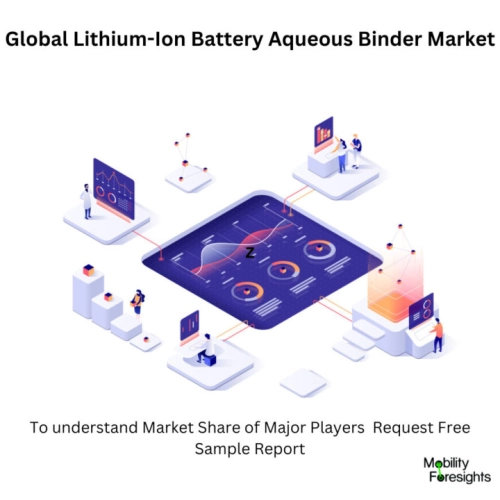
- Get in Touch with Us

Last Updated: Apr 25, 2025 | Study Period: 2023-2030
A thorough analysis of the structural and electrochemical behaviour of cell components is required to meet the demand for safer, more affordable lithium-ion batteries with increased energy density and longer life.
Binders, which join the active material and the conductive additive and firmly attach to the current collector, are an essential part of an electrochemical cell.
The characteristics of binders can change during device operation, which can cause active materials to be desquamated from the current collector and lead to capacity loss.
Here, we offer an in-depth analysis of the benefits and drawbacks of the conventional polyvinylidene fluoride (PVDF) binder, the relationship between PVDF and capacity loss, and the advancement of aqueous-based binders.
Even while aqueous-based slurry technology has generated a lot of interest across a wide range of fields, the goal of this study is to determine whether aqueous binders might help advance battery technology from a commercialization standpoint.
We discuss the main benefits and drawbacks of aqueous-based binders by rigorously evaluating the electrochemical performance of commercially viable anodes and cathodes.
Aqueous binders outperform metal oxide cathodes and low expandable graphite anodes, while their performance for highly expandable silicon anodes is subpar. In order to create high-performance binders for future battery technologies, considerable effort is needed.
The evaluation of the heat-curable polyurethane/carboxymethyl cellulose mixture as a binder for Li-ion battery electrodes is reported in this publication.
The experimental findings show PU's exceptional thermal and electrochemical durability as well as the excellent electrochemical performance of PU-bound cathode (NMC) and anode (graphite) electrodes.
The capacity of PU to stop current collector corrosion, which typically happens when an aqueous dispersion (slurry) of NMC is coated on aluminium foils, is the most significant discovery.
According to SEM analysis, PU encapsulates the positive active material particles, keeping the slurry's pH from rising. Finally, both half and complete lithium-ion cell setups are used to assess the cycling performance of anodes and cathodes based on PU/CMC.

The Global Lithium-Ion Battery aqueous binder market accountedfor $XX Billion in 2021 and is anticipated to reach $XX Billion by 2030, registering a CAGR of XX% from 2022 to 2030.
Electric vehicles, utility grids, and electronic devices have all made extensive use of lithium-ion batteries (LIB) as energy delivery and storage technologies.
The need to increase LIB's energy density is growing, nevertheless. Therefore, it is important to create novel electrode materials with high energy densities.
The weak connection and interface issue between the binder and the active material, large volume change, low ion/electron conductivity, and self-aggregation of active materials during charge and discharge processes are still problems, despite the discovery of numerous novel materials.
Currently, a promising candidate to overcome the aforementioned problems is the binder-free electrode. First, by attaching the active material directly to the conductive substrate, the interface issue between the binder and active materials can be resolved.
Lithium-ion batteries (LIB) have been widely used as energy delivery and storage technology in electric cars, utility grids, and electronic devices.
However, there is an increasing demand to boost the energy density of LIB. It is crucial to develop new electrode materials with high energy densities as a result.
Despite the discovery of various novel materials, issues with the weak bond and interface between the binder and the active material, substantial volume changes, low ion/electron conductivity, and self-aggregation of active materials during charge and discharge processes still exist.
The binder-free electrode is currently a viable candidate to address the aforementioned issues. First, the interface problem between the binder and active materials can be handled by directly attaching the active material to the conductive substrate.
| Sl no | Topic |
| 1 | Market Segmentation |
| 2 | Scope of the report |
| 3 | Abbreviations |
| 4 | Research Methodology |
| 5 | Executive Summary |
| 6 | Introduction |
| 7 | Insights from Industry stakeholders |
| 8 | Cost breakdown of Product by sub-components and average profit margin |
| 9 | Disruptive innovation in the Industry |
| 10 | Technology trends in the Industry |
| 11 | Consumer trends in the industry |
| 12 | Recent Production Milestones |
| 13 | Component Manufacturing in US, EU and China |
| 14 | COVID-19 impact on overall market |
| 15 | COVID-19 impact on Production of components |
| 16 | COVID-19 impact on Point of sale |
| 17 | Market Segmentation, Dynamics and Forecast by Geography, 2023-2030 |
| 18 | Market Segmentation, Dynamics and Forecast by Product Type, 2023-2030 |
| 19 | Market Segmentation, Dynamics and Forecast by Application, 2023-2030 |
| 20 | Market Segmentation, Dynamics and Forecast by End use, 2023-2030 |
| 21 | Product installation rate by OEM, 2023 |
| 22 | Incline/Decline in Average B-2-B selling price in past 5 years |
| 23 | Competition from substitute products |
| 24 | Gross margin and average profitability of suppliers |
| 25 | New product development in past 12 months |
| 26 | M&A in past 12 months |
| 27 | Growth strategy of leading players |
| 28 | Market share of vendors, 2023 |
| 29 | Company Profiles |
| 30 | Unmet needs and opportunity for new suppliers |
| 31 | Conclusion |
| 32 | Appendix |